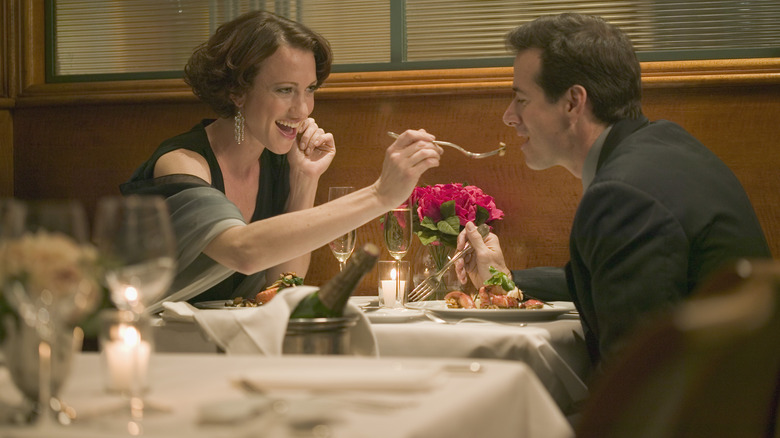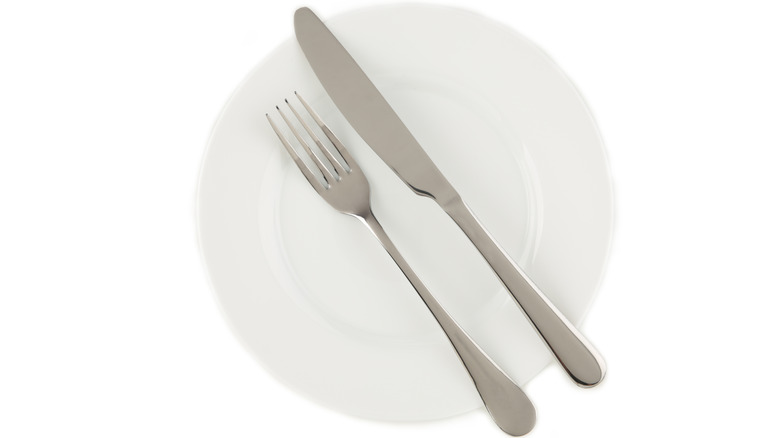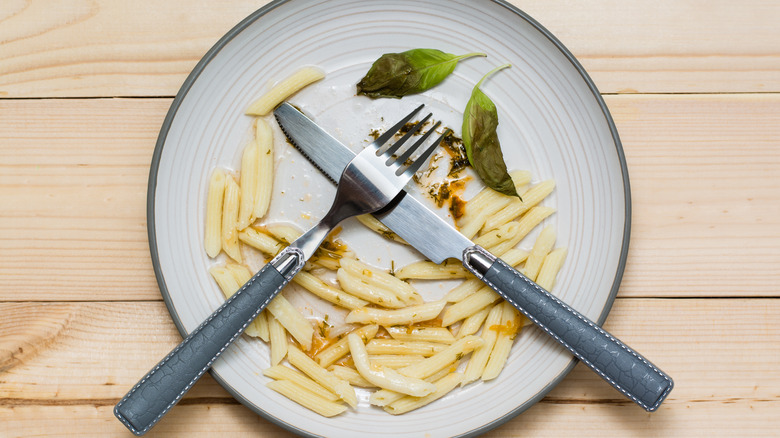Where Do I Put My Fork And Knife When I'm Done Eating?
If you're having dinner in a restaurant and the server has to ask if you're finished, that's likely because you're not placing your silverware properly on the plate as a cue. Yes, there is a way to leave your utensils that alerts staff as to whether you've finished eating or not. However, this is one of many etiquette rules that are not commonly followed, so if you're learning this for the first time, that's okay.
This restaurant etiquette rule is actually slightly different in Europe than it is in the U.S., but we'll start with the American version. When you've finished a course, you should place your utensils (typically a fork and knife) on top of the plate. Most etiquette guides use the clock method to explain the exact placement, with the handles of the utensils placed at 4 o'clock, and the tines or blades oriented diagonally to 10 o'clock. The fork should be situated below the knife, and the blade of the latter should be facing towards you.
If you happen to be dining in London, Paris, or elsewhere in Europe, the rule is almost the same, but with one variation. Turn your fork over so that the tines are pointing down instead of up.
Why this rule is important and common mistakes to avoid
If you know this rule, and have largely ignored it, that's probably because you're not aware of the reasoning behind it. Etiquette rules have invariably evolved as a way to be more considerate to both fellow diners and restaurant staff. In this case, you're saving servers the trouble of having to ask whether you've finished eating. However, be aware that in order to be considerate towards your fellow diners, you should try to finish each course at about the same time as they do. So wait to place your silverware in the proper position until almost everyone at the table has also polished off their food. The server will generally not clear the table until everyone is finished, anyway.
Aside from poor pacing, there are two other major mistakes to avoid when placing silverware atop the plate. The first is pushing your plate away. This makes the table more difficult to clear for restaurant staff and is an etiquette no-no. The other mistake is placing silverware incorrectly in the form of an X. No, this placement does not send the same cue to restaurant staff as the correct alignment. It's actually meaningless as a cue in the U.S., but it does make it more likely the silverware will fall off the plate while being bussed.
Other ways to cue servers
Correctly placing your silverware after each course indicates to your server that you speak the same language (that of dining etiquette). This helps with smoothness of service, and will result in a better dining experience for you and your dinner companions.
By the way, if you want to let your server know that you're not finished eating, rest assured there's an etiquette rule for this, too. The proper alignment is to lay the knife (blade down, facing left) atop the upper portion of the plate. Using the clock method, the knife should be horizontal at 12 o'clock. The fork, meanwhile, should have the handle at 4 o'clock, but slightly offset, so that the tines barely reach the middle of the plate as they point towards 10. That's the American method, anyway. The European method, again, is a bit different, and in fact, resembles the X we noted should be avoided. It's permissible in a continental setting (fork tines down), however.
Napkins, too, are frequently used as cues to savvy servers. Once the meal is complete, for example, the napkin should be placed on the table. No, not on the plate, or even where the plate may have been before being bussed. Place it to the left, where the forks were laid out previously. There's no need for any fancy folds, either. Just lay it there. Trust us, your server will know what it means.



